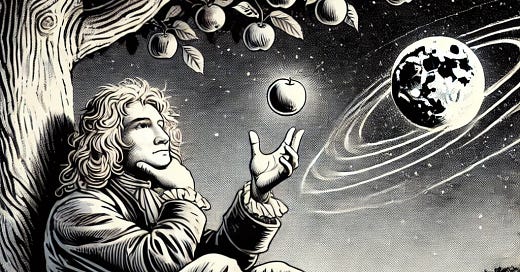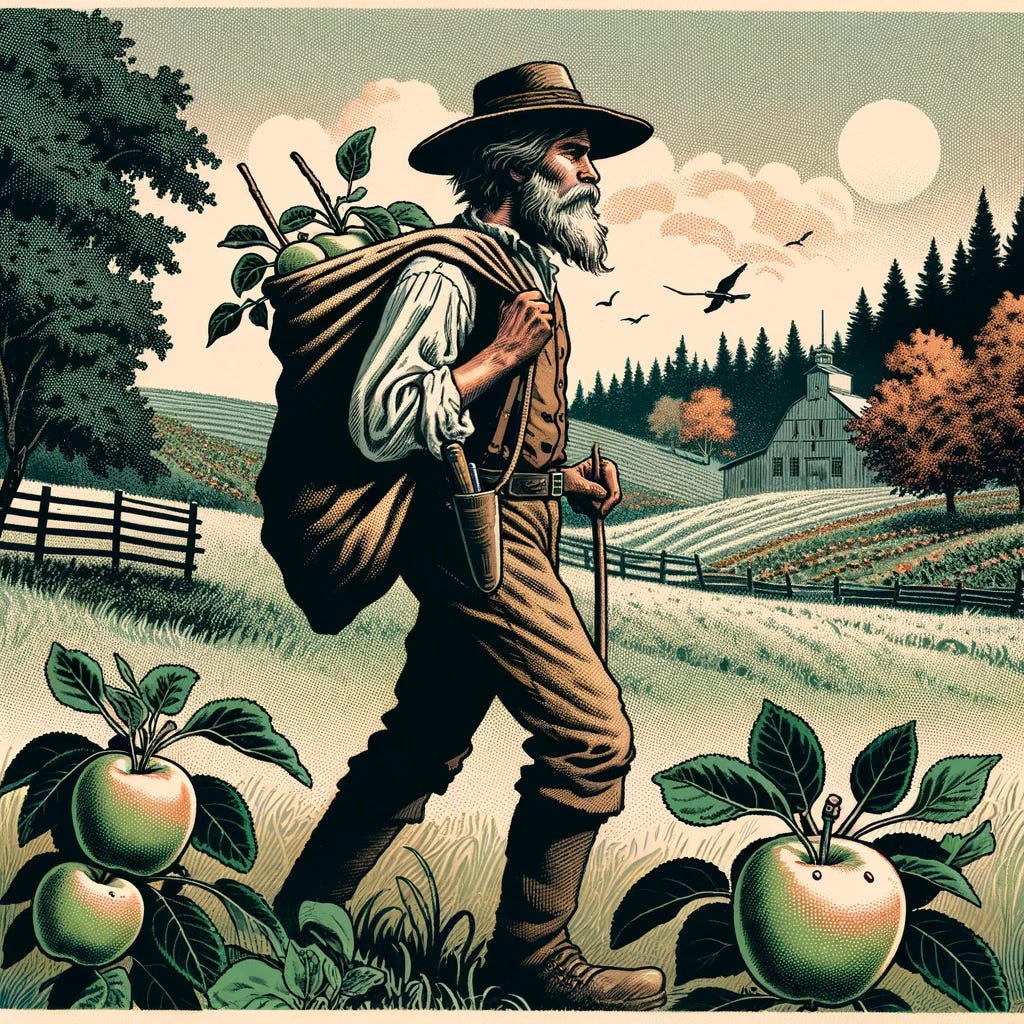In 1665, an apple didn’t fall on Sir Isaac Newton’s head.
I should maybe rephrase that to state that we don’t know about any particular apples that actually fell on Sir Isaac’s head, although we certainly do tell stories about one particular apple falling as though it really happened.
Here’s what I wrote about this supposed aha moment:
That’s what was going on when Sir Isaac was sitting down underneath that old apple tree, contemplating why the Moon didn’t simply fall down to the planet, when the universe sent him the most incredible and ironic gift. An apple fell from the tree, hitting him in the head!
Suddenly, in a flash of brilliance, Isaac understood that the Moon and the apple were actually caused by the exact same phenomenon, which came to be known as Newton’s Universal Theory of Gravitation.
This is an inspiring story that leaves you in awe of moments of inspiration through serendipitous events. This type of story tells you that divine inspiration sparks in an instant, and that’s how genius works, and how good ideas get out into the world.
It’s all nonsense, and it’s honestly pretty insulting to the powerful intellectual process that was going on during that annus mirabilis—miracle year. No apple fell on Newton’s head, connecting celestial objects to terrestrial ones for the first time. Instead, lots of deep, quiet thinking and hard work went into this understanding.
Here, a fruit landing on someone’s head invoked a loss of innocence. In a flash, Newton understood everything about gravity, or so the tale goes.
Hmmm… fruit trees and innocence. Now where have I heard that combination before?
Oh yes! We have to go way back to our founding myths for the perfect example. All the way back to the very beginnings, to when humans roamed the countryside and cut down trees on a regular basis.
I’m talking about George Washington and the cherry tree, of course.
The story goes that when little George was only six years old, his father gave him a hatchet as a gift. Naturally, George went out playing with this dangerous toy, ultimately cutting his father’s cherry tree. This was old man Washington’s favorite tree, and George knew he was in for it.
Nevertheless, our great founder responded with the utmost integrity and courage, stating boldly:
I cannot tell a lie.
This is every bit as true as the tale about Newton, which is to say that it seeks to make a point about the person and the incident, rather than to tell an actual narrative. In the case of little George and his cherry tree, the author didn’t even see fit to include this incredible story in the first five editions of The Life of Washington, published in 1800. Given that this was almost immediately after Washington’s death, it seems like it would have been included if there was any truth to it.
Soon after the time of Washington, another fruit-based myth cropped up here on American soil. This was based on a living person, though: religious missionary John Chapman would travel from town to town planting apple seeds during the early 19th century.
Eventually, pamphlets describing his work started calling him John Appleseed, and after his death in the mid-19th century, Chapman’s legend really began to grow. By the mid-20th century, the Walt Disney company told a sanitized tale of a man who went from town to town, planting apple trees and toting a Bible with him.
Johnny Appleseed’s legend was meant to represent American pioneering and thrift, and probably mainstream Christian religious beliefs, but there are a few things to understand about the OG Appleseed. First, he wasn’t mainstream anything.
John Chapman was a follower of Swedenborgianism, also called the New Church. Nature and God were interwoven, and members rejected the doctrine of the trinity, something anathema to mainstream followers of both Protestantism and Catholicism.
Maybe even more interestingly, these apple seeds were not for apples to be eaten. Instead, John Chapman planted seeds that would grow into cider apples, producing a potent potable that everyone over a certain age could enjoy.
Our legends tend to say whatever it is that we want them to say, and our stories tend to bend in order to accommodate this burning need. Looking back at what really happened and comparing it to reality can tell us a lot about ourselves.
With Johnny Appleseed, it seems as though the apple has been rewritten as a symbol of innocence, invoking the Garden of Eden. Perhaps Newton’s tale can also be derived from Eden, given that in both myths, a fruit unlocked vast troves of hidden knowledge.
Washington is the outlier with his cherry tree, but it’s almost as though it could have been any sort of fruit-bearing tree. The story we want to tell here is of a President who refused to become a king, stepping down when he certainly didn’t have to, and when crowds were roaring at his back for four more years. The point is that Washington is honest, just like the tree that grows from the land.
With Newton, the point is instant insight. I hate this myth the most because it diminishes how actual innovation and invention happen, elevating “divine insight” in a flash by one person, while it takes an army of people standing on the shoulders of giants, and that certainly included Newton himself.
Insight, as such, doesn’t usually come down from the heavens so much as people standing on the shoulders of giants climb up there and grab it for themselves.
Appleseed’s myth seems to be about fecundity and abundance. It’s easy to live in a world where sharing is common if the things you need are abundant, and Appleseed makes it a point that you need to plan to become abundant, planting seeds for eventual wealth to grow.
The stories we tell ourselves about these real people from the past—they’re all shaped by what we need those stories to tell us today. We need to hear that insight can happen in a flash so that we watch out for those moments, and we need to know that it’s okay to tell the truth when we break something.
We remember things a certain way so that we can remember the lessons we want people to learn.






In each of these cases, a mythological story about a famous man has overtaken the reality of the man's life, simplifying the achievements each of them made into easily accessible stories.
Newton worked in multiple fields of science, education and public service, yet the apple anecdote is all most people know about him. Washington was painted in hagiographic terms by his biographer, Parson Mason Weems, that allowed readers to accept that he could not tell a lie, even though he obviously could and did (though not to the degree later politicians do), and thus to give a moral example to young Americans. As for John Chapman/Johnny Appleseed, the denial of the fact that he practiced a controversial alternative to Christianity and that his apples were meant for alcoholic beverages and not food were things necessarily removed by Disney to keep things simple.
In all of them, we can see that the necessity of separating fact from fiction has been a longer and more arduous process than most people would think.
Next you’ll tell me the cow didn’t jump over the moon or that Little Boy Blue didn’t stick his thumb in a pie and say something about it. Whatever.